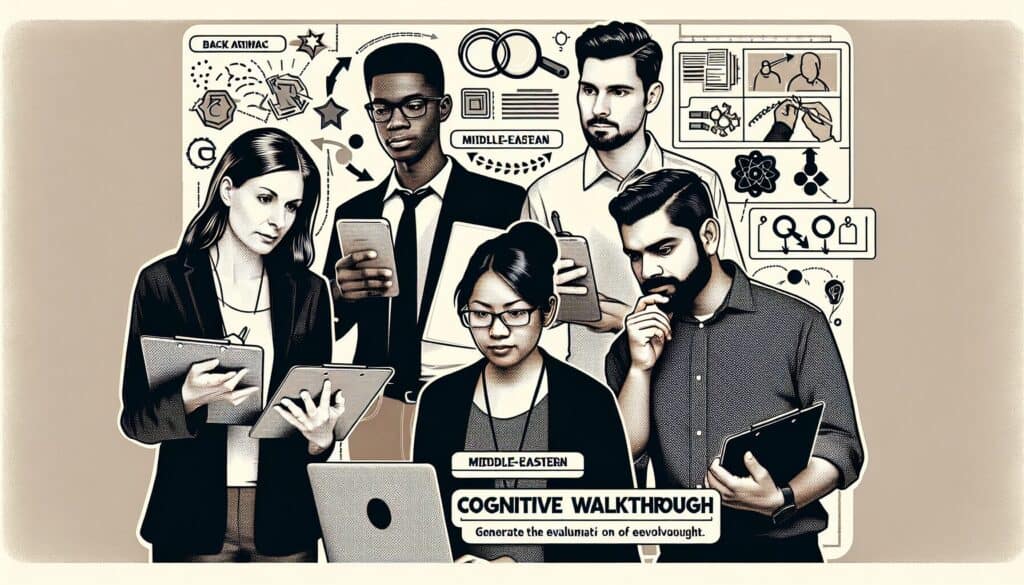To evaluate the usability of a product by having evaluators go through a series of tasks, step-by-step, to see if users can easily learn how to operate the system.
- المنهجيات: الهندسة, الجودة
Cognitive Walkthrough

Cognitive Walkthrough
- الحوسبة الإدراكية, تقييم التصميم, التفكير التصميمي, التفاعل بين الإنسان والحاسوب, سهولة الاستخدام, تجربة المستخدم (UX), واجهة المستخدم (UI), اختبار المستخدم, تصميم يركز على المستخدم
الهدف:
كيفية استخدامه:
- Evaluators simulate a user's problem-solving process at each step in a predefined task, asking a set of standard questions about learnability and ease of use.
الايجابيات
- Identifies specific usability issues related to learnability for new users; relatively inexpensive and quick to perform.
سلبيات
- Focuses primarily on novice users and learnability, may miss issues for experienced users; effectiveness depends on the expertise of the evaluators.
الفئات:
- تصميم المنتج, الجودة
الأفضل لـ
- Identifying potential usability problems for new users trying to accomplish specific tasks.
Cognitive Walkthrough is widely employed in the early phases of user interface and experience development, particularly in industries such as software design, web development, and mobile app creation, where understanding how new users will interact with a product can shape its design. This methodology is initiated by usability experts or members of a design team who articulate the specific tasks new users might undertake within the system. Participants typically include the evaluators conducting the walkthrough, as well as team members who can provide insights into user needs and behaviors, such as product managers, user experience designers, and developers responsible for implementation. In executing a Cognitive Walkthrough, evaluators systematically ask a series of predefined questions at each interaction point to assess learnability and ease of use, facilitating a thoughtful examination of the user interface from the perspective of a novice user. This structured approach not only surfaces potential usability issues but also allows for a rapid evaluation process that contributes to iterative design cycles. The findings from this methodology can inform enhancements to product features or user instructions, promoting a more intuitive experience for first-time users. Various organizations, including startups and established corporations, can benefit from integrating Cognitive Walkthrough into their design process, especially when developing new applications or redesigning existing ones that need to accommodate users unfamiliar with the system.
الخطوات الرئيسية لهذه المنهجية
- Define the user tasks relevant to the product being evaluated.
- Choose specific user goals and scenarios for the walkthrough.
- Step through the task, simulating a new user's interaction with the product.
- At each action required, evaluate if users would know what to do.
- Assess whether users would notice that the correct action is available.
- Determine if users would associate the correct action with the desired outcome.
- Evaluate if users would successfully execute the action to achieve the goal.
نصائح للمحترفين
- Involve a diverse team of evaluators with varying familiarity to ensure a broader perspective on usability challenges.
- Incorporate user feedback iteratively throughout the walkthrough to align scenarios more closely with real-world contexts.
- Utilize task success metrics along with qualitative observations to quantify learnability issues effectively.
لقراءة عدة منهجيات ومقارنتها, نوصي باستخدام
> مستودع المنهجيات الشامل <
مع أكثر من 400 منهجية أخرى.
نرحب بتعليقاتكم على هذه المنهجية أو المعلومات الإضافية على قسم التعليقات أدناه ↓، وكذلك أي أفكار أو روابط متعلقة بالهندسة.
السياق التاريخي
1986
(إذا كان التاريخ غير معروف أو غير ذي صلة، على سبيل المثال "ميكانيكا الموائع"، يتم تقديم تقدير تقريبي لظهوره الملحوظ)

منشورات ذات صلة
محاكاة مونت كارلو
الاختبار المستند إلى النموذج
التحقق من النموذج
بحوث الأساليب المختلطة
تدقيق الأخطاء (بوكا يوك)
اختبار الملف الشخصي للمهمة